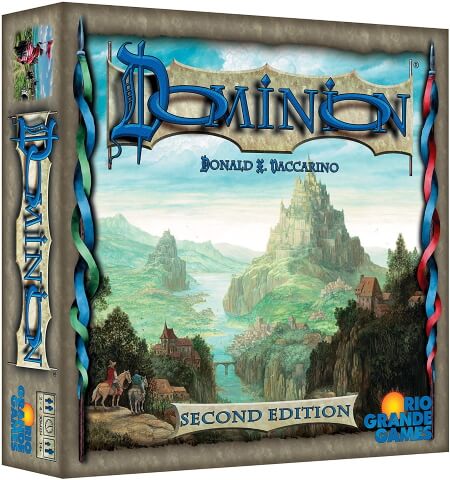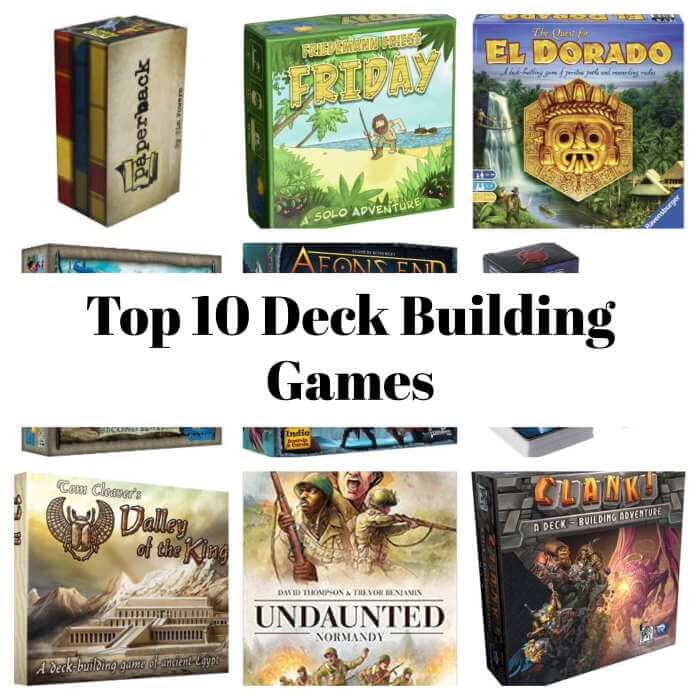
Drawing cards, playing cards, buying cards, and cycling through a deck – in a nutshell, that’s what deck-building games are all about.
The idea in a deck-building game is that you begin with a deck of cards that is relatively we weak, but throughout the game, you acquire additional cards to add to your deck to improve its power, efficiency, and ability to help you quickly advance toward victory in the game.
According to BoardGameGeek, Dominion was the game that pioneered this mechanism, and, as you will see reflected in this list, this mechanism has certainly been borrowed and expanded upon in fascinating ways since this game was released 2008.
Whether you are an experienced gamer looking for a new deck-building game to try, or you are new to board games all together and are looking for a game that features cards, here are 10 deck-building games worthy of your time.
1. Dominion – The Pioneer of Deck-Builders
It wouldn’t make much sense to make a list about deck-building and not include the game that started it all. Winning the Spiel des Jahres in 2008, the year it was released, and gaining 18 expansions over the years since then, Dominion is a game that quickly rose to popularity and has remained relevant as a staple in many hobby board gamers’ collections.
It wouldn’t make much sense to make a list about deck-building and not include the game that started it all. Winning the Spiel des Jahres in 2008, the year it was released.
Dominion at a Glance
| Game Type Medieval Theme. Card Game, Deck Building, Take That, Variable Setup | Play Time 30 mins | Skill/Complexity (2.5 - 5) Light - Medium |
| Age 13+ | Publisher(s) Rio Grande Games | Published 2008 |
| Categories Strategy | Players 2 - 4 | Cost $34.99 |
| Related Games Like Dominion - Top Picks | Our Rating 9.4/10 |
If you are looking for a place to begin with deck-building games, or you’ve never tried it before for whatever reason, then Dominion is definitely one to try at least once. At the very least, it will help you appreciate the various iterations of this mechanism that exist.
Gameplay – The main idea in Dominion is that you are a monarch attempting to have the most prosperous dominion by adding various people, events, buildings, estates, and money into your land. In the game, players take turns using cards from their hands to perform actions and buy additional cards, which make their turns much more powerful on future turns. Cards can allow players to perform many additional items during their turn: actions, cards, purchases, and money, not to mention the ability to get rid of less-powerful cards from their deck. The ultimate goal is to have the most victory points (VPs), which players accrue by purchasing estate (1 VP), duchy (3 VP), and province (6 VP) cards on their turn; however, the main catch is that these cards that provide VPs go into a player’s deck and do not provide any ongoing benefit other than end-game points. As such, players must decide when to purchase VPs as to not clog up future hands with cards that do not help their turn. The game ends once the province card supply pile is empty, or three card piles are empty, and whoever has the most VPs is the winner of the game.
What makes Dominion an excellent game for any top deck-building games list isn’t just the fact that it was the pioneer of the genre – it really does maintain its status as a fun, quick game of pure deckbuilding.
If you are looking for a challenge of building an efficient deck, and enjoy exciting turns with lots of bonuses and combos, then Dominion is a game that focuses almost exclusively on that aspect.
It doesn’t have a board to navigate or anything else to worry about other than drawing cards, playing cards, and buying cards. And with all the expansions currently available, you would be hard-pressed to ever feel like you’ve “seen everything there is to see” with this game.
2. Valley of the Kings – A Big Game in a Small Package
One of the biggest drawbacks to the board gaming hobby is the limitation of physical space; whether it’s storage space in one’s home, or space in a bag or backpack on a trip or on the way to a gathering with friends or family, the physical size of a game is something that can pose issues.
Yet, it’s not necessarily always the case that a game has to be physically big to offer a big, brain-burning experience. Valley of the Kings, designed by Tom Cleaver, certainly falls into this category: a big game in a small package.
Valley of the Kings, designed by Tom Cleaver, certainly falls into this category: a big game in a small package.
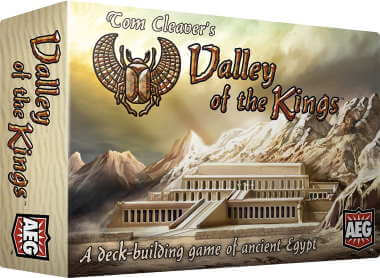
Valley of the Kings at a Glance
| Game Type Ancient Theme. Card Game, Deck Building, Set Collection, Card Drafting | Play Time 45 mins | Skill/Complexity (2.5 - 5) Light - Medium |
| Age 14+ | Publisher(s) Alderac Entertainment Group | Published 2014 |
| Categories Strategy | Players 2 - 4 | Cost $59.99 |
| Our Rating 9/10 |
In Valley of the Kings, players are preparing for their own death as an Egyptian noble and attempting to fill their tomb with valuable artifacts.
Gameplay – As in other deckbuilding games, players take turns using cards from their hand to acquire more cards and perform actions. But there are a couple of aspects of the game that set Valley of the Kings apart. First, each card can be used in a few different ways (but can only be used for one purpose on a player’s turn). Players can: use the gold value listed on the card to purchase additional cards, perform the action listed on the card, or entomb the card by removing it from their deck and placing it into their tomb. Since players only earn points for the cards in their tomb – not their deck – at the end of the game, trying to decide when to remove cards (and lose its action power for the rest of the game) is an agonizing balancing act.
Lastly, players earn points for the number of cards in each set within their tomb by squaring the number of unique cards in a set. For instance, if they have just one card in a set, it will only be worth one point, but having seven cards in a set will score 49 points. Trying to gain a lot of cards in a set rather than spreading thin with cards of many sets helps add a challenging dimension when deciding which cards to purchase.
While there is certainly a lot more to be said about Valley of the Kings, the big takeaway for this game is that it’s packed full of challenging choices to make in a really small box.
If you are looking for a game that is easy to take along to game night or throw in your bag for a trip, and is quick to set up, yet offers a similar experience to a large box game, then Valley of the Kings is one you may very much enjoy.
3. The Quest for El Dorado – A Racing Game Well-Suited for Beginners
When the opportunity arises to introduce a non-gamer into the world of hobby board gaming, deciding which game to bring along can be a difficult choice with many aspects to consider. However, if you are looking for a deck-building game that is well-suited for both gamers and non-gamers alike, then The Quest for El Dorado by Reiner Knizia is one that can work equally well with both groups.
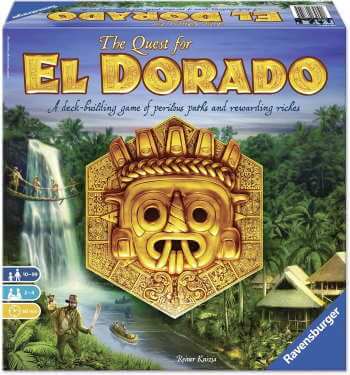
The Quest for El Dorado at a Glance
| Game Type Adventure, Card Drafting, Deck Building, Hexagon Grid, Modular Board, Racing | Play Time 30 - 60 mins | Skill/Complexity (2 - 5) Light |
| Age 10+ | Publisher(s) Ravensburger | Published 2017 |
| Categories Family | Players 2 - 4 | Cost $45.95 approx |
| Our Rating 9/10 |
While The Quest for El Dorado features deck-building mechanisms that aren’t incredibly original – drawing cards, playing cards, performing actions, buying cards from a market, and discarding – what distinguishes this game is the fact that it uses racing as a way to make the strategic aspect of deck-building easy to understand.
What distinguishes this game is the fact that it uses racing as a way to make the strategic aspect of deck-building easy to understand.
Gameplay – In order to reach El Dorado, players must traverse a board full of different terrain types and blockades to overcome. Using cards from their hand, players on their turn can move across terrain matching the same type of card they played, provided their card meets the movement cost requirement indicated on the board. They can also use gold, or other cards, from their hand to purchase cards from the market, which offer benefits like more powerful movement abilities, diversified terrain crossing abilities, or the ability to remove cards from their deck.
The fact that The Quest for El Dorado blends racing with deck-building means that turns are almost guaranteed to be quick, and the end of the game can ramp up to be very exciting.
The game is also incredibly easy to teach to non-gamers because the winning conditions are ultra-easy to understand, and the visual aspect of the board helps to make the concept of deck-building easier to grasp for someone who has never played a game in the genre.
The Quest for El Dorado also has an interesting two-player variant in which both players control two adventurers, and to win the game, a player must be the first to have both of their adventurers reach the city. This creates an interesting challenge of how to balance movement between the two pawns.
4. Star Realms – A Lightning-Speed Two-Player Game
Sometimes there is nothing more fun than getting to the end of a quick 15-minute game, and wanting to play again—and again, and again. When a game can pack a lot of excitement into a really small amount of time, and feel addicting, then it’s likely one that will see a lot of table time. Star Realms is definitely one of these games.
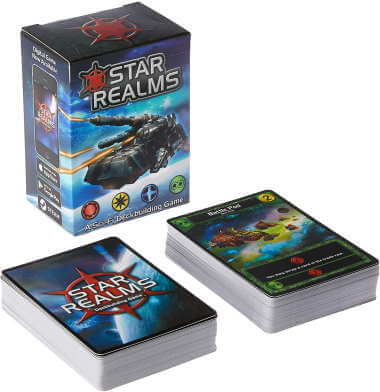
Star Realms at a Glance
| Game Type Card Game, Science Fiction, Card Drafting, Deck Building, Delayed Purchase , Take That, Kickstarter (crowdfunded) | Play Time 20 mins | Skill/Complexity (2 - 5) Light |
| Age 12+ | Publisher(s) White Wizard Games | Published 2014 |
| Categories Strategy / 2 Players | Players 2 | Cost $14.99 |
| Our Rating 8.5/10 |
Star Realms, designed by Robert Dougherty and Darwin Kastle, is another game on this list that comes in an incredibly small package, and comes at a very affordable price tag.
Star Realms, designed by Robert Dougherty and Darwin Kastle, is another game on this list that comes in an incredibly small package, and comes at a very affordable price tag.
Gameplay – In the game, players are trying to be the first to deplete their opponent’s 50 life points. This game offers a huge sense of quick progression and engine building; a player may only attack with a couple or few hit points per turn at the beginning of the game, yet it’s not uncommon to pull off turns with 20+ hit points at the end of the game just 10-15 minutes later. The fun twist that Star Realms utilizes to add to a player’s sense of progression is with card combos. There are four different factions of cards that players can purchase from the card market on their turn, and certain cards provide bonuses when they are played alongside cards of the same faction. Some cards also provide bonuses for trashing the card from play. These powerful bonuses incentivize players to specialize in one or two factions, and the trash abilities help to boost bonuses at just the right time in order to perform a massive turn – and possibly decide the game.
Because of its quick gameplay, Star Realms is an easy game to play with a friend during a lunch break at work. If you can find someone who is willing to play many games of this with you, then you will both likely have a blast in trying different combinations with the different factions.
There are also expansions you can add to mix things up, as well as an excellent app implementation that features online gameplay.
5. Paperback – A Deck-Building Word Game
Who would have thought that the deck-building mechanism and word game genre would be combined to make a game could be appealing to fans of both worlds?
Paperback, designed by Tim Fowers, manages to do just that: it builds upon ideas from classic word games like Scrabble and blends it with deck-building elements found in other games, like Dominion, and creates a unique experience that lends itself well to a variety of gaming scenarios.
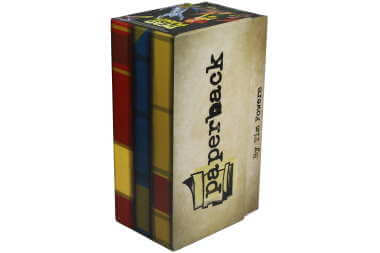
Paperback at a Glance
| Game Type Card Drafting, Cooperative, Deck Building, Delayed Purchase | Play Time 45 mins | Skill/Complexity (2 - 5) Light |
| Age 8+ | Publisher(s) Fowers Games | Published 2014 |
| Categories Strategy / Family Word Game | Players 2 - 5 | Cost $32.99 |
| Our Rating 8.7/10 |
The goal of Paperback is to be the most successful author by publishing novels for fame points, which are represented on the fame cards that players acquire throughout the game.
Gameplay – Players begin the game with a starting deck consisting five wild cards, and five letter cards (R, S, T, L, and N). After shuffling their deck, and drawing a hand of five cards, players take turns forming a word from their hand (using letters, wilds, and a shared common letter on display). They then add up the value of their cards on the top left, and can use that value as currency to purchase additional cards from the display to add into their discard pile. A player can also gain the common card currently displayed for free if their word length meets the requirement for that card. Cards that players purchase provide a wider variety of letters to use on future turns, and some provide an additional action they can trigger on their turn, such as the ability to draw additional cards. Players can also purchase fame cards, which provide points at the end of the game and serve as a wildcard if drawn on their turn.
Paperback would be a great fit for those who enjoy word games, and have friends or family that enjoy word games too.
Paperback would be a great fit for those who enjoy word games, and have friends or family that enjoy word games too.
This could be a great game to bring along to family game nights to play as an alternative to classic word games, and perhaps as a way to introduce non-gamers into the world of hobby board games.
While this game may not necessarily persuade someone who hates word games to suddenly love them, it does have the power to appeal to fans of deck-building games who may not otherwise seek word games out but who are open to the experience.
6. Clank! – A Deck-Building Adventure
Diving into the depths of a dangerous dragon layer to steal plunder, fighting monsters along the way, and trying to escape the wrath of the dragon with the most riches – Clank! is a game that brings deck-building and a dungeon-crawl theme together for a game that is full of excitement and tension.
Will players push their luck and try to dive down deeper into the dragon keep in order to get higher-valued artifacts, and risk defeat? Or will they play the safe route and take try to ensure a safe passage, but with plunder of lesser value? Whichever route they choose, there’s one thing for certain: players definitely don’t want to wake the dragon.
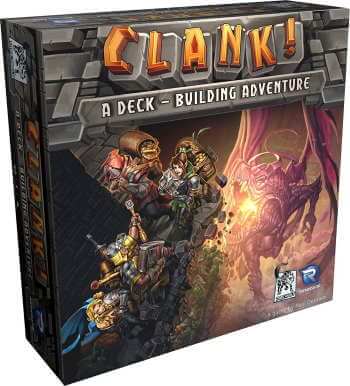
Clank! at a Glance
| Game Type Adventure, Fantasy, Card Drafting, Deck Building, End Game Bonuses, Pick-up and Deliver, Point to Point Movement, Player Elimination, Push Your Luck, Variable Set-up | Play Time 30 - 60 mins | Skill/Complexity (2.5 - 5) Light - Medium |
| Age 12+ | Publisher(s) Renegade Game Studios | Published 2016 |
| Categories Strategy / Family | Players 2 - 4 | Cost $66.99 |
| Our Rating 9/10 |
Clank!, designed by Paul Dennen, is a deck-building game that features a player board where players traverse the tunnels of a dragon keep in order to uncover secrets and gather loot.
Clank!, designed by Paul Dennen, is a deck-building game that features a player board where players traverse the tunnels of a dragon keep in order to uncover secrets and gather loot.
A player begins their turn with five cards in their hand, and plays them in order to perform actions, such as moving around the board, fighting monsters, and acquiring new cards for their deck from the display with skill points.
The goal is to obtain an artifact token, make it out of the dungeon, and have the greatest number of points from their artifact token and other goods they have acquired along their journey.
Gameplay – The aspect of Clank! that makes it especially unique is the fact that certain cards make players cause “clank,” which are cubes of their color that represent the accidental noise that they cause as they are traversing the dungeon – and drawing the attention of the dragon. When a card is revealed that triggers a dragon attack, all players’ clank cubes in the clank area are thrown into the dragon bag (along with black dragon cubes), and a number of cubes are drawn equal to the dragon’s current location on the rage track. If a black dragon cube is drawn, nothing occurs; however, if a cube is drawn of a player’s color, that player adds the cube to their health tracker, representing damage incurred. Any cubes that are not drawn remain in the bag, so the more clank a player causes, the more likely they are to suffer damage from dragon attacks. Once a player has escaped the dungeon or has been knocked out, they move their player marker to the countdown track at the top of the board, and move forward on each successive turn, causing dragon attacks to players who have not yet escaped. On the last space of the countdown track, all players who have not escaped are knocked out. Players must have collected an artifact and have escaped the depths in order to be eligible to count their points at the end of the game.
If you are looking for a deck-building game with some thematic fantasy flair, then Clank! will likely be a game that you enjoy.
Despite the fact that it contains some fairly standard deck-building mechanisms, the theme comes to life as players decide how much to push their luck and risk causing clank in order to snag some more valuable loot.
The clank cubes themselves make sense thematically; adventurers, by nature, will cause some accidental noise, and the more noise they cause, the more likely they are to attract unwanted attention from the dragon.
This game could be a huge success with fans of fantasy-themed dungeon crawls who are looking for something different, as well as euro-gamers who want a deck-building game with some fresh ideas and light-hearted gameplay.
7. Undaunted Normandy – A War Game in 45-60 Minutes
War games are notorious for being long, complicated games that take a considerable time investment to enjoy and appreciate.
Fortunately, lighter, more accessible war games have come into the hobby board game market, such as Memoir ’44, that attempt to capture the essence of a war game and the historical theme, but with much easier-to-grasp rules and quick gameplay. Undaunted Normandy is one of these games, and brings the World War II battlefield theme with deck-building mechanisms together in a captivating way.
Fortunately, lighter, more accessible war games have come into the hobby board game market.
Undaunted Normandy at a Glance
| Game Type Thematic, Wargame, Card Drafting, Deck Building, Dice Rolling, Modular Board | Play Time 45 - 60 mins | Skill/Complexity (2.5 - 5) Light - Medium |
| Age 14+ | Publisher(s) Osprey Games | Published 2019 |
| Categories Strategy / Wargame 2 Players | Players 2 | Cost $39.99 |
| Our Rating 9/10 |
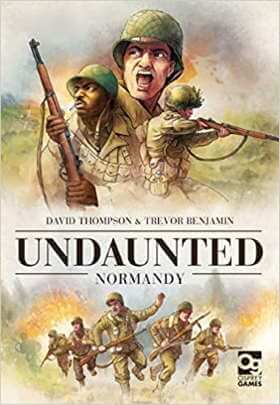
Gameplay – Undaunted Normandy, designed by Trevor Benjamin and David Thompson, is a 2-player card-driven combat game in which one player takes on the role of the Allies, and the other player commands German forces. The game comes with 12 scenarios, each of which has a different terrain setup, winning objectives, as well as different cards that will be used in each player’s deck.
Each round begins by players drawing four cards into their hand. Then, both players simultaneously select and reveal one card from their hand to use as initiative for that round. Whichever player selected a card with the highest initiative value will begin that round (cards used for initiative are discarded). On a player’s turn, they play cards from their hand into their play area to perform actions; their turn continues until they are out of cards or don’t wish to play any more cards, at which point they discard all their cards. There are three types of actions players take on their turn as indicated on cards they play: movement, support, and combat. Movement actions typically allow players to scout new tiles, and move units to tiles that have already been scouted. Support actions provide various benefits to a player, like adding cards from their supply to their discard pile, or gaining control of a current space on the board. Combat actions allow a player to attack their opponent by targeting a unit, rolling an attack die, and evaluating casualties based on the result of the die roll and the opponent’s defense value. If a player suffers casualties, they must remove a matching card from the game as represented on token their opponent attacked. As this is a deck-building game, once a player runs out of cards to draw, they shuffle their discard pile. The game ends once one player has achieved the winning conditions for the round.
If you are a fan of World War II or military history, and are looking for a relatively lightweight and easy-to-teach war game that you can play with friends or family who share your same interest in this subject, then this is a game you may want to consider.
The deck-building mechanism in this game provides a unique spin to the war game genre, and the fact that the game includes 12 different scenarios means that this game has a fairly large amount of replayability included in the base game.
8. Aeon’s End – A Cooperative Struggle to Defend
You and a group of fellow breach mages are survivors of a tragic invasion, and are striving to protect the human city of Stronghold from the nameless faces of evil that would wreak havoc upon all that you hold dear.
In Aeon’s End, designed by Kevin Riley, you must work together as a team to defeat a nemesis by casting spells and utilizing each player’s unique ability, before the nemesis destroys your city.
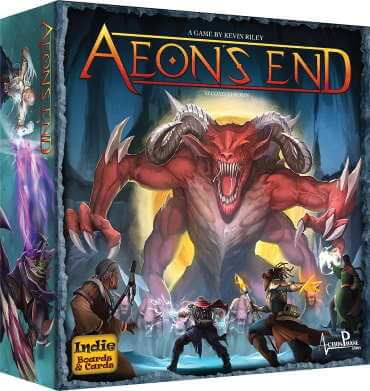
Aeon’s End at a Glance
| Game Type Fantasy, Science Fiction, Card Drafting, Cooperative, Deck Building, Delayed Purchase, Variable Phase Order, Variable Player Powers Solo/Solitaire | Play Time 60 mins | Skill/Complexity (2.9 - 5) Medium |
| Age 14+ | Publisher(s) Action Phase Games and others | Published 2016 |
| Categories Strategy | Players 1 - 4 | Cost $39.99 |
| Our Rating 9.2/10 |
Aeon’s End is fully-cooperative deck-building game in which players take on the role of a unique breach mages, each of which has special abilities and a different starting hand/deck.
Aeon’s End is fully-cooperative deck-building game in which players take on the role of a unique breach mages, each of which has special abilities.
Gameplay – The base game comes with four nemeses, and players select one to attempt to defeat for a given game. This game has a unique way of determining player order – instead of taking clockwise turns, there is a turn-order deck which includes cards for each player as well as the nemesis. This deck is shuffled, and the card that is drawn from the top of the deck determines which player (or nemesis) takes a turn. On a player’s turn, they can cast a prepped spell from an open breach to deal damage to the nemesis or a minion, and can then perform various actions such as playing gem or relic cards (to gain aether, the currency in the game, or to resolve effects like gaining life), buying cards (and placing them on top of their discard pile), paying aether to gain a charge (which allows them to unlock their special ability), focusing or opening a breach (which allow them to cast spells), or prepping a spell to a breach. Unlike standard deck-building games, players do not shuffle their discard pile once their draw pile is depleted; instead, they flip over their discard pile and draw from the top. In other words, the order in which they draw cards does not change. On the nemesis’s turn, players resolve the effects of minion or power cards currently in play, and then draw a new card from the nemesis’s draw pile, which can be attack cards, or minion/attack cards that can provide immediate effects and remain in play until eliminated.
The game ends and players win once the nemesis’s life points have been depleted to zero, or if the nemesis’s draw pile is depleted and there are no minion or power cards in play. The game ends and players lose if Gravehold reaches zero life, or if all players reach zero life.
The fact that Aeon’s End offers these slight yet interesting changes to typical deck-building mechanisms means that the game will likely feel fresh for gamers who have played several other deck-building games.
The fantasy theme will also likely appeal to fans of the genre, though being a fan of the fantasy genre is in no way a prerequisite to enjoy this game.
The game is rated as a medium-weight, and the fact that it is a cooperative game by nature makes it easier to teach due to the fact that all players are working toward the same goal.
9. Friday – A Solo Survival Challenge
Enjoying a deck-building game doesn’t need to be limited to situations when you have other people to play with – Friday, designed by Friedemann Friese, has managed to create a deck-building game specifically to be played as a solitaire experience.
In this game, you play the role of Friday, who attempts to help Robinson Crusoe survive on your island after he becomes stranded, and ultimately defeat pirates that are going to attack.
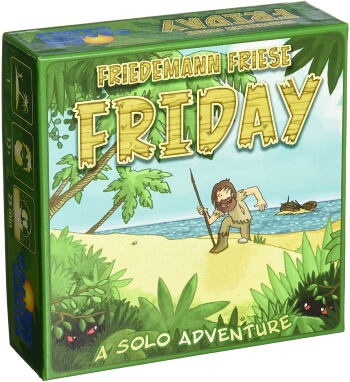
Aeon’s End at a Glance
| Game Type Fantasy, Science Fiction, Card Drafting, Cooperative, Deck Building, Delayed Purchase, Variable Phase Order, Variable Player Powers Solo/Solitaire | Play Time 60 mins | Skill/Complexity (2.9 - 5) Medium |
| Age 14+ | Publisher(s) Action Phase Games and others | Published 2016 |
| Categories Strategy | Players 1 - 4 | Cost $39.99 |
| Our Rating 9.2/10 |
The ultimate goal of Friday is to survive a journey through the dreadful hazard deck’s three stages of difficulty (green, yellow, and red) and then defeat two randomly-selected pirate ships (each ship has different winning conditions).
The ultimate goal of Friday is to survive a journey through the dreadful hazard deck’s three stages of difficulty (green, yellow, and red).
Gameplay – As is typical in deck-building games, a player begins a game of Friday with a deck of relatively weak cards, and the goal is to gain better powers and abilities throughout the game in order to become more efficient. In the game, a player gains additional cards by defeating hazard cards, and they do so by drawing a certain number of cards from their draw pile as indicated on the hazard card they are facing, in hopes that their fight points meet or exceed the current hazard value. The player can pay life points to draw additional cards from their deck if they wish. If a player fails, the hazard card goes back into the hazard deck, and they lose life points equal to the difference between the hazard value and the fighting points from their cards; as a bonus, however, they can also pay one life point to destroy a card they played on their turn. If they succeed, then they gain the hazard card into their discard pile and turn it upside down to use the fight card side. A unique aspect of this deck-building game is that once a player exhaust’s their draw pile, they add a random “aging” card to their discard pile before shuffling. These aging cards make it more challenging for a player to succeed at a hazard if drawn, and in order to destroy the aging card they must lose against a hazard card and pay two life points.
Friday is definitely a challenging game to beat, and is one that rewards multiple plays to learn the subtle strategies of building an efficient deck in order to ultimately defeat the two pirate ships at the end.
The unique deck-building mechanisms of this game also feel fitting to its theme of survival and learning skills over time.
If you are looking for a deck-building game to play solitaire that is difficult to master, and will provide hours of entertainment, then this is game could certainly provide the experience you are looking for.
10. Trains – Ticket to Ride Meets Dominion
It is your calling to become the leader of the most powerful railway company in Japan. To do so, you must outsmart your competition by strategically placing railways, building stations in cities, reducing waste, and buying structures – all in a more efficient way than your opponents.
Trains, designed by Hisashi Hayashi, blends familiar route-building and deck-building mechanisms in a way that provides a game with quick, interesting decisions.
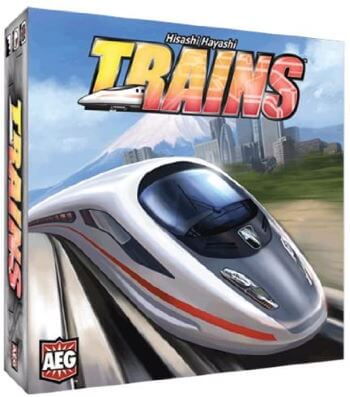
Trains at a Glance
| Game Type Train Theme, Card Drafting, Network and Route Building | Play Time 45 mins | Skill/Complexity (2.5 - 5) Light to Medium |
| Age 12+ | Publisher(s) Alderac Entertainment Group and others. | Published 2012 |
| Categories Family / Strategy | Players 2 - 4 | Cost $55.99 |
| Our Rating 8/10 |
If you are a fan of Ticket to Ride and/or Dominion, and are looking for a “next step” game, then this is going to be one that may appeal to you.
The goal in Trains is to end the game with the most VPs, which players achieve by the cards in their deck and the placement of their railways.
If you are a fan of train themed board games – you might find our Top Picks of Train Themed Games a great read.
Gameplay – Players begin the game with basic cards that allow them to build railways and stations, and provide money to purchase other cards. Each player also places one starting rail token on the board before the first turn. On a player’s turn, they play cards from their hand and purchase cards from their supply, in any order they choose, and all of their cards at the end of their turn go into their discard pile. They can use cards for both the action indicated on the card, as well as the money value listed at the top. A player must build rail tokens in spaces that are adjacent to a space where they already have a token, and there are additional costs to build if the space is on a river, mountain, city, or remote location. There is also an additional cost if a player builds in a space where there are other players’ rail tokens present (they also have to draw a waste card when they do so, which provide no action and can clog up future hands). The game ends once one of three conditions have been met: any four piles of cards from the supply are depleted; any player is out of rail tokens; or the station token supply has been exhausted. Then, players gain VPs from the cards in their deck, rail tokens in cities with stations (the more stations, the more VPs), and the point values listed on remote locations where they have rail tokens.
Trains is a game that is suited for hobby board gamers and potentially casual gamers who have at least been exposed to a couple modern board games.
The rules of the game are not complex, the actions depicted on the card are easy to grasp, and the ways to score points are very clear.
While the mechanisms of the game will feel familiar to those who have played similar route-building or deck-building games, it is certainly one that is well-polished and engaging to deserve a space in a game collection.
That’s about it for the Best Deck-Building Games – Our Top 10 Picks category for now!
